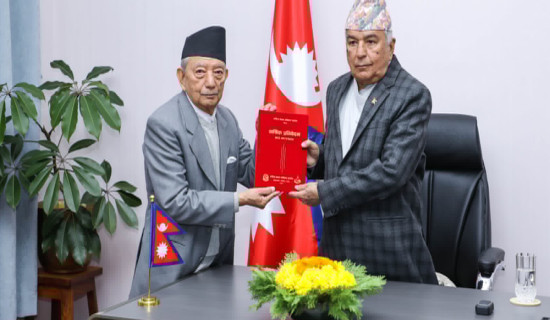- Sunday, 7 December 2025
Chart Path To South Asian Prosperity
South Asian sub-continent, which hosts 2.08 billion people, is going through multiple challenges posed by growing geopolitical tensions, trade deficit, debt challenges and climate vulnerabilities. Over the last few years, India has, however, registered a robust growth in its economy, pushing up the collective average growth rate of South Asia, though the individual economic performance of smaller countries of this region remains bleak. The World Bank South Asia Update has projected South Asia's GDP growth at 6.5 per cent for 2024/2025. But the absence of a sustainable foundation for economic surge in smaller countries is likely to affect the collective average growth of the region in the years to come.
As an economic and geopolitical power of South Asia, India is blazing the path of economic recovery for other countries of this region as well. According to the World Bank's Global Economic Prospects (GEP), India's economic growth is projected at 6.7 per cent for fiscal years 2026 and 2027. However, almost all other countries of the region, except Bhutan, which has upgraded itself from the LDC category primarily through exporting hydro electricity to India and branding itself as an eco-tourism destination, are facing a bleak situation marked by dwindling export trade, escalating geopolitical tensions, climate vulnerability, inflation and food insecurity.
Diversifying productive resources
Smaller countries of South Asia are facing the problems in diversifying productive resources, raising life standards, dealing with climate vulnerabilities and maintaining peace and stability. However, their economic prospects are most affected by geopolitical volatility brought about by the rivalry between China and India on the one hand and India and Pakistan on the other.
Bound by the principle of non-alignment, the smaller countries of South Asia have maintained neutrality in the power rivalry of the regional powers, focusing on their independent path of development within the regional framework of cooperation as specified in the Charter of the South Asian Association for Regional Cooperation (SAARC). These countries have also actively participated in other regional and sub-regional cooperation forums like BIMSTEC and BBIN to leverage their economic potential.
South Asian countries share many commonalities and contradictions. Although the South Asian countries represent a vast geographical, ethnic, cultural and climatic diversity, most of them share the same reality of underdevelopment, geopolitical constraints, inadequate transport connectivity, poor service delivery and weak framework of regional cooperation. Almost all the countries of South Asia are rich in agricultural resources. Nepal, Bhutan, the Maldives and Sri Lanka lack a sound manufacturing base, while India and Bangladesh possess significant industrial infrastructures.
Of all the countries of South Asia, Nepal has abundant water resources with an economically feasible generation potential of 43,000 MW. Considered as the Water Tower of Asia, Nepal's Himalayas also stand as an inexhaustible source of drinking water. However, the unfortunate part of the story is that climate change is causing the Himalayan snow to melt, degrading the ecological stability and hydrological cycle of the region. Smaller countries of this region are contributing more than their share to protect the ecological balance of this region, but in the absence of a functional regional body to oversee and coordinate efforts, it has become increasingly difficult for them to mobilise funds and international advocacy.
As an agricultural country where 66 per cent of the people still depend on land resources for a living, Nepal has been contributing to maintaining the ecological balance of the region through environmentally sustainable farming. Nepal's fertile land and abundance of water for irrigation make it an ideal food basket but its agricultural farming is yet to become a commercially viable enterprise. For lack of quick and timely access to international markets, farmers are compelled to suffer losses as green vegetables and fruit products easily perish during transportation. Even high-value products like black cardamoms, which Nepal and Bhutan produce in significant quantities, are losing profitability due to a lack of connection with the international supply chain.
The only high-profile regional organisation, SAARC, which had once inspired hope among the people of the region, has remained dysfunctional because of a growing rift between India and Pakistan. Unlike SAARC, the Association of South East Asian Countries (ASEAN) has, however, evolved into a vibrant and effective cooperative mechanism helping member countries to tap available resources, expand markets, build connectivity and help resolve internal disputes. However, growing distrust among the nuclear power countries of this region has not only hindered multilateral cooperation but has also affected bilateral engagement between China and other South Asian countries.
Nepal, Bangladesh, the Maldives and Sri Lanka are facing painful stagnation in their development initiatives. Nepal's effort to attract Chinese investment for a cross-Himalayan transport and connectivity project has been in limbo because of India's displeasure about this project. Similarly, China's investment in Hambantota and Colombo Port in Sri Lanka also comes under controversy. Because of the inability of the Sri Lankan Government to serve the mounting debt, China has taken over the Hambantota Port on a lease for 99 years. Western countries are saying that the Chinese investment has put Sri Lanka into a vicious debt trap.
Bitter experience
Bangladesh also shares a bitter experience about its cooperation with China. China invested in some game-changing projects in Bangladesh, like Karnaphuli Underwater Tunnel, Padma Bridge, Dhaka Elevated Highway and others, which are now under intense controversy. The tiny Indian Ocean island state, the Maldives, also found itself caught in the geopolitical storm because it accepted China's support in building transport and tourism infrastructures on the Island. Pakistan is also not faring well in its collaboration with China in managing the China-Pakistan Economic Corridor running from Kashi to Gwadar Port.
Smaller South Asian countries want to chart out a collective path to prosperity but they do not appear free to do so without paying heed to sobering geopolitical reality reflected on the chessboard of regional power players. But the reality check reveals that there is a lesson for regional powers also. If they do not realise the futility of conflict and "stay out of each other's backyards" as advised by Professor Jeffrey D Sachs during a recent interview with Palki Sharma, an Indian TV host, the aspiration for South Asian prosperity may remain a dream forever.
(Dr. Bharadwaj is a former ambassador and former chairperson of Gorkhapatra Corporation. bharadwajnarad@gmail.com.)















